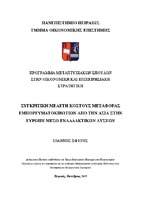Συγκριτική μελέτη κόστους μεταφοράς εμπορευματοκιβωτίων από την Ασία στην Ευρώπη μέσω εναλλακτικών λύσεων
A comparative study of the transportation cost of containers from Asia to Europe via alternative routes

View/
Subject
Εμπορευματοκιβώτια ; Εμπορεύματα -- ΜεταφορέςAbstract
This assignment examines whether shorter routes in container transport, from a port in Asia to one in Europe, would be more beneficial in comparison to longer routes, which will be using the economies of scale that appear with the gigantism of ships, more extensively.
More specifically, an analysis of the operating cost of the ships of both aforementioned cases has been conducted and with the use of financial models, the most advantageous is determined.
The main objects of this study are:
- The examination of the conditions of sea transport.
- The new trends that arise in ship purchases.
- Inquiries about the purchases of containerships.
- Detailed analysis of containerships' operating cost.
- Examination of the effects that the increase of containership size has on operating cost.
- The influence that a lower operating cost of containerships could have to the selection of a route in the market of Asia and Europe.
The first chapter deals with the structure of the maritime market and more specifically, the structure of maritime transport and its chronology, by using many qualitative data.
In the second chapter, there is a comprehensive description of the container shipping industry. All types of container ships, the ways cargo is transhipped, the infrastructure required in ports to service these ships and all the managing companies, which in recent years seem to have a tendency to gigantic their fleet, aiming to greater profits by exploiting economies of scale are reported extensively in this chapter.
The third and final chapter refers to all the operating costs that a container ship has and by using specific models, the operating costs of three different sized container ships for the Eurasian market are elaborated. The ships in this study use different sea routes, though, and that's in order to ascertain whether the economies of scale in very large ships engaged on a much larger journey, overcome the profits of smaller ships which operate in a much shorter route.


